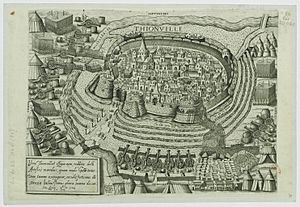Siege of Thionville (1558) facts for kids
Quick facts for kids Siege of Thionville |
|||||||
|---|---|---|---|---|---|---|---|
| Part of Italian War of 1551–59 | |||||||
 |
|||||||
|
|||||||
| Belligerents | |||||||
| Commanders and leaders | |||||||
| Jean Carrebe | Francis, Duke of Guise seigneur de Vieilleville Piero Strozzi † |
||||||
| Strength | |||||||
| 3,000 50 culverins or other artillery pieces |
12,000-14,000 30,000 |
||||||
| Casualties and losses | |||||||
| 1,500 | 400 dead 1,000 wounded |
||||||
The Siege of Thionville was a major battle that took place in 1558. It was part of the Italian War of 1551–59. The French army, led by Francis, Duke of Guise, attacked the town of Thionville. At the time, Thionville was controlled by the Spanish forces. The siege lasted from April 17 to June 23, 1558. In the end, the French army won the battle.
Contents
Why Was Thionville Important?
After capturing Calais, the French leader, Duke of Guise, wanted to attack the Spanish. Henry II of France decided to focus his army on Thionville. This town was one of the strongest places held by Charles V, Holy Roman Emperor. Many people thought it could not be captured.
Thionville was also a threat to the French town of Metz. So, Metz sent soldiers and cannons to help. Other soldiers from places like Toul and Verdun also joined. These troops arrived on April 26, 1558. They came to help the soldiers of seigneur de Vieilleville. Vieilleville's troops had already started surrounding the town nine days earlier. They arrived quietly, without drums or trumpets, to keep their arrival a secret.
How the Siege Began
Vieilleville's soldiers started digging trenches around Thionville on April 17. They cut off the town's food supply. On April 26, more French and German soldiers arrived. This allowed them to completely surround Thionville.
In early May, Duke of Guise sent a message. He said he was coming with more soldiers. He arrived on May 28 with Piero Strozzi. The French army now had about 12,000 to 14,000 soldiers. Some sources even say it was 10,000 French and 20,000 German soldiers. The Spanish defenders inside Thionville had only about 3,000 men. They also had 50 cannons. Their commander was Jean Carrebe.
Vieilleville prepared many boats with cannons and gunpowder. They set up their main camp near the Moselle river. Spanish soldiers tried to bring help to Thionville. But the French guards were too strong. They could not get through. Other attempts to send help also failed.
The Battle Unfolds
On the third day, the French set up a large cannon near the Moselle river. They also placed six other big cannons. These cannons were only about 1,500 paces from the town. Their powerful shots badly damaged Thionville's defenses. They also destroyed all of the town's cannons.
The French and German forces then attacked the southeast side of the town. They focused on the Tour-aux-Puces and nearby walls. They broke through the walls. French soldiers tried to rush in, but they were pushed back. They lost about one hundred men. For the next four days, both sides fired muskets at each other.
On June 21, Piero Strozzi was checking the cannon positions. He was hit in the throat by a musket shot from 500 paces away. He died about thirty minutes later. His death was kept a secret. This was to make sure the soldiers' spirits did not drop. Vieilleville took full command again. He decided to attack the town from a different side. He moved the large cannons to new spots. These spots were perfect for firing at the main street and the Luxembourg gate. He also asked Metz for more cannons.
Four cannons fired at one tower for a whole hour. It was so damaged it looked like a dovecote. When a hole was made in the wall, French soldiers rushed in. They captured the tower. Vieilleville led soldiers to dig a new trench. He moved two cannons into it. These cannons fired into the town, shaking the walls.
The next day, Vieilleville put on all his armor. He led his best soldiers, ready to enter the town or die trying. The people of Thionville fought hard against the first attack. They pushed the French back. But then, thirty French soldiers launched a second attack. They got into the town shouting, "France! France! The town is won!"
Surrender and Aftermath
Duke of Guise then called for a meeting with Jean Carrebe, the town's commander. He sent a messenger to say that if the defenders did not leave within three hours, his soldiers would harm everyone. This included women and children. Carrebe tried to set his own terms for surrender. But Guise refused. He said the losers could not tell the winners what to do. He fired a few more shots at the town's houses.
Carrebe then surrendered completely. The Spanish soldiers and the town's people were allowed to leave. But they could not leave with full military honors. This meant no drums, trumpets, or flags. They could only take their swords. All other weapons were left behind. The French army took control of Thionville on June 23.
Some suggested destroying Thionville's walls. This was to get back at them for the destruction of Thérouanne in 1553. But Guise said no. The people of Thionville had fought so bravely. Guise did not let any of them stay. So, new people from Metz had to move in. They bought the houses in Thionville.
However, the Peace of Cateau-Cambrésis happened the next year. This peace treaty gave Thionville back to the Spanish. The French army left the town. The original people of Thionville came back to their homes. But the town had been badly damaged during the French occupation. It took a long time for it to become prosperous again.


